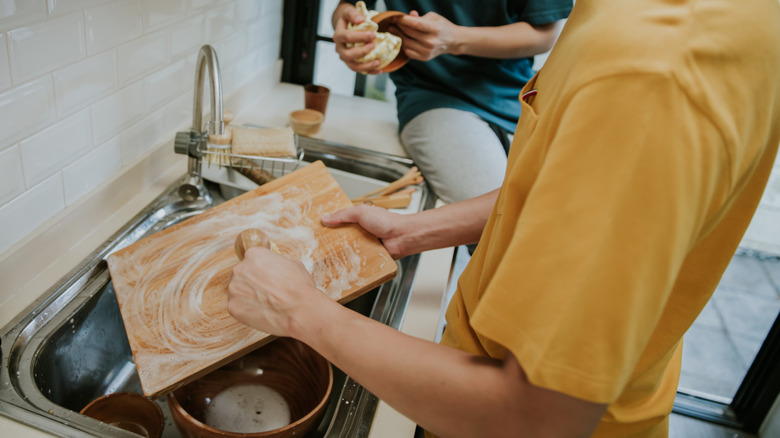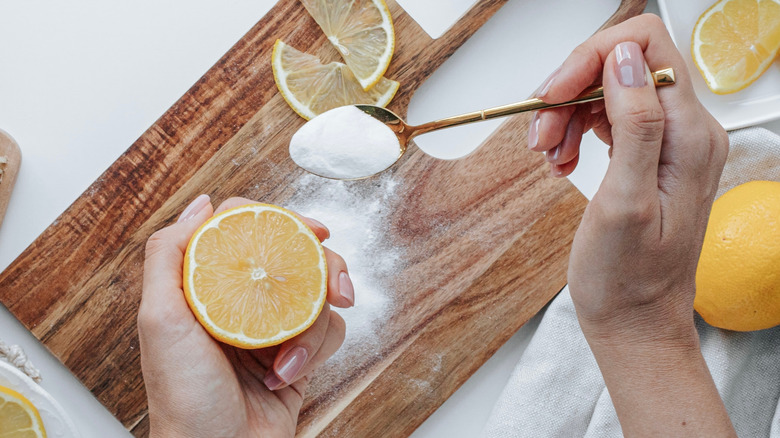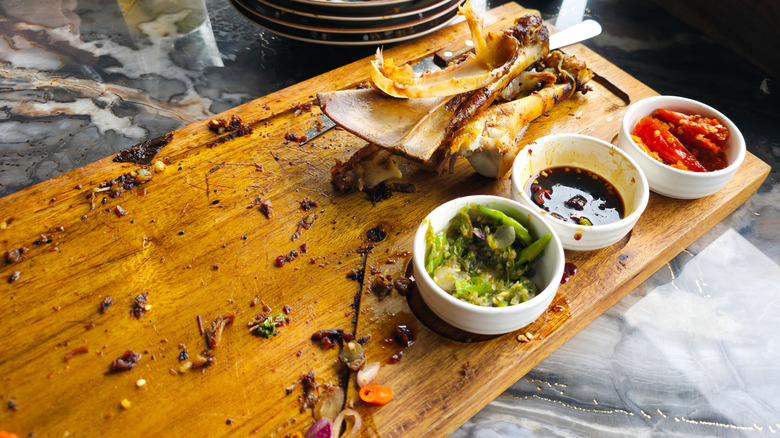How To Remove Smells From Wooden Serving Boards (Without Damaging The Wood)
No one wants to serve appetizers or charcuterie on a wooden board that smells bad. Unfortunately, some serving or cutting boards develop a bit of funk over time, and it can be hard to know how to get rid of it. You could put it in the dishwasher, but that leaves the wood cracked, faded, or deformed. Soaking it does pretty much the same thing, and often the smell still remains. While there are a few wrong ways to clean wooden serving boards, the right way involves a lemon as well as a few other helpful ingredients, namely baking soda, salt, and especially mineral oil
Which of these ingredients you use really depends on how major your problem is. If you want stains gone as well as lingering smells, use the cut side of half a lemon to rub in some baking soda. For really nasty odors, rub in some salt instead. Salt is naturally abrasive and remains gentle enough for wood surfaces. The mineral oil is just for the end, and will help keep your serving board nice looking after its much-needed lemon-induced glow up.
How to get the most success with the lemon method
This trick is pretty simple, no matter which variant you use. After a vigorous rubbing with a lemon half and your abrasive of choice, let the board marinate in the juice and salt/baking soda paste until it looks dry. Rinse off the mixture entirely and dry the board with a towel, then give it a good sniff test to ensure the stink is gone before conditioning with mineral oil.
But remember, there are still some mistakes you can make. Lemon is the secret key to removing stink, but leaving it on for too long can have a serious impact on the wood's quality. The acid can break down the material and can cause cracking, so you must get all of it off before storage. Once you are done rinsing off all the lemon, you should also be sure to hand-dry the board thoroughly. This is a very important step, so the wood won't degrade and warp over time from moisture. If you don't have a lemon on hand, vinegar or hydrogen peroxide may work for the mixture, but they may be too harsh for antiques unless diluted.
Always store the board upright after applying butcher block conditioner or mineral oil. These vital products prevent wood from becoming brittle and thirsty, and this is an oft-missed step after the lemon deodorizing method. Make sure you add the oil monthly, and your wood serving or cutting boards will remain perfect for entertaining party guests for years to come.
Keep your serving board from smelling bad in the first place
One sniff may have you wondering if it's time to throw out your serving board, so you should understand why wood starts to stink in the first place. Wood is a porous material, which means it absorbs small amounts of whatever is resting on its surface. It also holds moisture after washing if not dried quickly and completely. Both of these factors make for an easy breeding ground for odor-producing bacteria. Once a board develops cracks, that bacteria-growing ability gets even worse.
Another reason wood boards have a tendency to smell is what's served on them. Charcuterie is often put onto wooden serving platters for long periods, letting smells and oils soak in. Charcuterie and other fun party appetizers are generally moist or high-fat foods, which are exceptionally good at seeping into porous wood. So, to really get rid of unpleasant aromas, you'll need lemon to break down set-in food particles while killing off any lurking bacteria.
However, the actual best way to get stink out of your serving board is to prevent its cause. Line the board with parchment paper to act as a barrier against oils and food particles. You might also consider serving things that are low-moisture, so there's less contaminating liquid to absorb. Most of all, clean food off the wood immediately after use so it won't stain or seep into the material. While lemon can help you after the fact, these techniques can stop the problem before it even starts.


